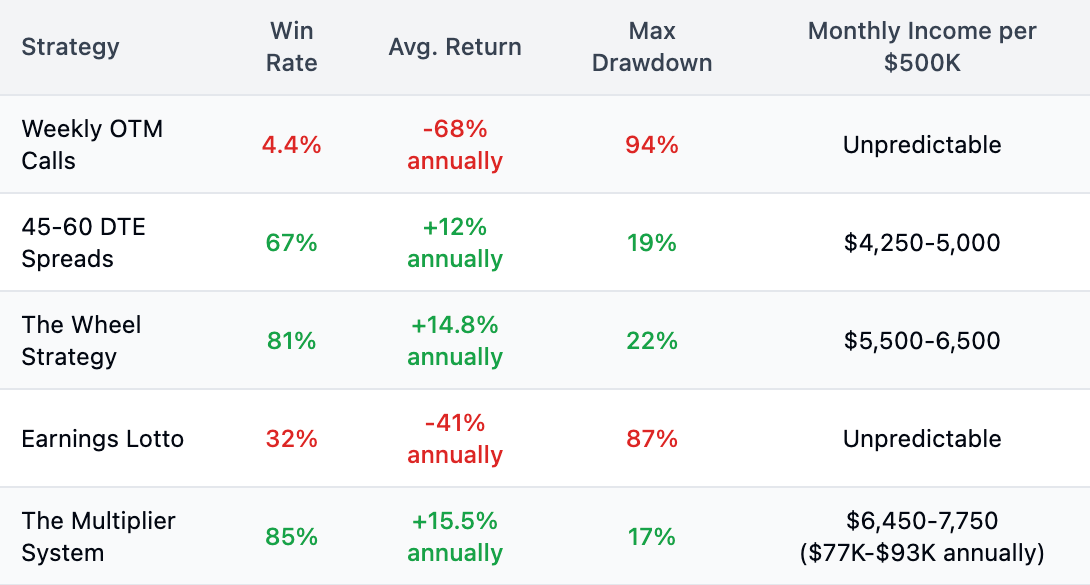I once lost $47,000 in exactly 3 minutes and 22 seconds on a "sure thing" options trade.
That's not the kind of story they tell at investment conferences or print in glossy financial magazines. But it's exactly this painful lesson—and four others like it—that separates actual traders from theoretical ones.
These five reality checks cost me six figures to learn.
Master them, and you can transform a sleepy 2% dividend portfolio into a 15-18% annual income machine.
Truth #1: You're trading mathematics, not stories
When you buy that call option on Apple, you're not "investing in Tim Cook's vision."
You're trading volatility, time decay, and probability distributions.
If terms like IV crush, theta decay, and delta hedging aren't in your vocabulary, you're essentially bringing a water pistol to a nuclear war.
Back in 2019, I bought TSLA calls before earnings, confident in their delivery numbers. The stock jumped 8% after hours. I went to bed dreaming of profits. By market open, my options were down 35%.
Why?
IV crush obliterated my premium despite the stock moving in my direction.
The mathematics trumped the narrative.
This realization fundamentally changed my approach and, as a result, VADER's delta-focused selection strategy.
Instead of buying options on the latest stock story, I now sell options against my dividend growth holdings, letting mathematics work in my favor rather than against me.
Truth #2: Weekly OTM lottery tickets are Wall Street's ATM
That thrilling feeling when your out-of-the-money weekly call shoots up 300%?
It's the same dopamine hit that keeps Vegas in business.
Back in 2012-2013, I tracked 250 weekly OTM call purchases in my trading journal over two years. Results: 11 winners (average gain 287%), 239 losers (average loss 92%).
Net result: a 68% drawdown and a painful lesson in probability.
When I finally switched to selling 45-60 DTE spreads on quality companies in 2014, my returns stabilized at 11-13% annually—outperforming the S&P's 9.61% with significantly lower volatility.
The additional benefit — fewer transactions meant lower commissions and more favorable tax treatment, saving roughly 1.8% in after-tax returns.
This is precisely why when writing The Multiplier, I focus on 30-45 DTE covered calls and cash-secured puts on quality dividend stocks.
The data doesn't lie.
Here's how different approaches stacked up in my personal trading history:
Get My Latest Cash-Secured Puts Recommendations:
Go Premium For Full Multiplier Access ↓
Truth #3: Time is ruthless, so make it your ally
Options decay.
It's not a possibility—it's mathematical certainty.
Every weekend, every holiday, every hour, premium evaporates from bought options.
You can transform time from your enemy into your ally by flipping the script and becoming the seller rather than the buyer.
When you sell options, that same inevitable decay works in your favor—every passing day puts money in your pocket rather than taking it away.
Think of it this way: would you rather sell insurance policies or buy them?
Insurance companies exist because, over time, they collect more in premiums than they pay in claims. The occasional hurricane might cause a big payout, but the math works in their favor across thousands of policies.
This fundamental insight drives my investing philosophy.
By selling put options on stocks you want to own anyway, you collect premiums upfront.
If the stock never drops to your strike price, you keep the premium as pure profit.
If it does drop and you get assigned, you've essentially been paid to buy a stock at your target price—one that will continue generating dividends while you sell covered calls against it.
Truth #4: Earnings plays are for gamblers, not income builders
"I've got inside information on this earnings report," said my former colleague right before losing $30K on META puts last year.
The market doesn't reward good or bad results—it rewards surprises, which are inherently unpredictable.
Yet the day after earnings presents a mathematical edge.
Here's why:
Implied volatility (IV) spikes before earnings, making options expensive
IV collapses after the announcement (the "crush"), even if the stock moves
However, IV often remains elevated for 1-2 days post-earnings
This creates a brief window where option sellers can collect outsized premiums while risk is normalizing
For example, Home Depot typically sees a 4-5% post-earnings move, but options initially price in 7-8%.
By selling a put with a strike 12% below market the day after earnings, you're collecting premium for volatility that historical data suggests won't materialize.
This strategy effectively lets you sell insurance when the hurricane has already passed, yet premiums haven't fully adjusted.
It's like selling umbrellas after it stops raining, but people are still willing to overpay.
Truth #5: No exit plan = guaranteed disaster
"I'll see how it goes" is options trading for "I plan to panic at the worst possible moment."
Early in my trading career, I remember entering an iron condor on SPX without a clear exit strategy.
When the position moved against me, I froze—unable to decide whether to take the loss or adjust.
That indecision turned a manageable 15% loss into a 55% bloodbath over three excruciating days.
This expensive lesson transformed my approach.
Since then, before entering any position, I write down three numbers:
Take profit at: 50% of max potential gain
Cut losses at: 25% of capital at risk
Close position: 7 days before expiration regardless of P/L
Without these predefined exit points, your emotions inevitably become your trading strategy—and emotions are notoriously terrible at managing risk.
Paper Trading: A Must Before Risking a Dime
Before risking actual retirement funds, commit to at least 8 full weeks of paper trading.
One of my readers put it best: "I paper traded for 3 months and 'made' $11,800. Then I started with real money and lost $4,200 in two weeks. The difference? Emotions. I went back to paper trading for another month and only then was I ready."
Most trading platforms offer paper trading, but I personally recommend thinkorswim's paper money platform for its realistic option chain displays and "Analyze" tab features.
Paper trading isn't just about learning mechanics—it's about discovering how your psychology responds to market movements without real money at stake.
The technical aspects of options trading are actually quite straightforward; it's managing your own behavior that proves most challenging.
Too many income seekers skip this step, only to abandon options entirely after an emotionally driven loss.
Essential Options Books Worth Every Penny
I've read plenty of options books.
These three IMO actually matter for serious income investors:
"Trading Options Greeks" by Dan Passarelli - The clearest explanation of the mathematics that drives options pricing. As reader Sarah T. said: "This book saved me from losses before I even knew I was at risk."
"Options as a Strategic Investment" by Lawrence McMillan - Not light reading, but the most comprehensive reference guide available. Keep it on your desk.
"The Options Playbook" by Brian Overby - The most accessible explanation of strategies for beginners without sacrificing depth.
Knowledge is your edge in a market filled with sophisticated players.
These books won't make you an overnight millionaire, but they'll help you understand what's actually happening when option prices move in seemingly counterintuitive ways.
I hope you found these hard-earned lessons valuable in your own income journey.
Sometimes, the most important insights come from the painful lessons rather than the easy wins.
Unlike buying and holding dividend stocks alone, which might yield 2-4% annually, adding disciplined options strategies can multiply your income by 3-4x while maintaining or even reducing overall portfolio risk.
The market rewards neither optimism nor pessimism, but preparation and discipline.
I’ll be back on Sunday with the fresh covered call picks for Premium subscribers.
Thank you for tuning in today and supporting my work!
Mike Thornton, Ph.D.
P.S. If you're new to options and found this article helpful, you might want to check out my step-by-step guide:
I break down exactly how to implement these principles with real examples from my own portfolio.









